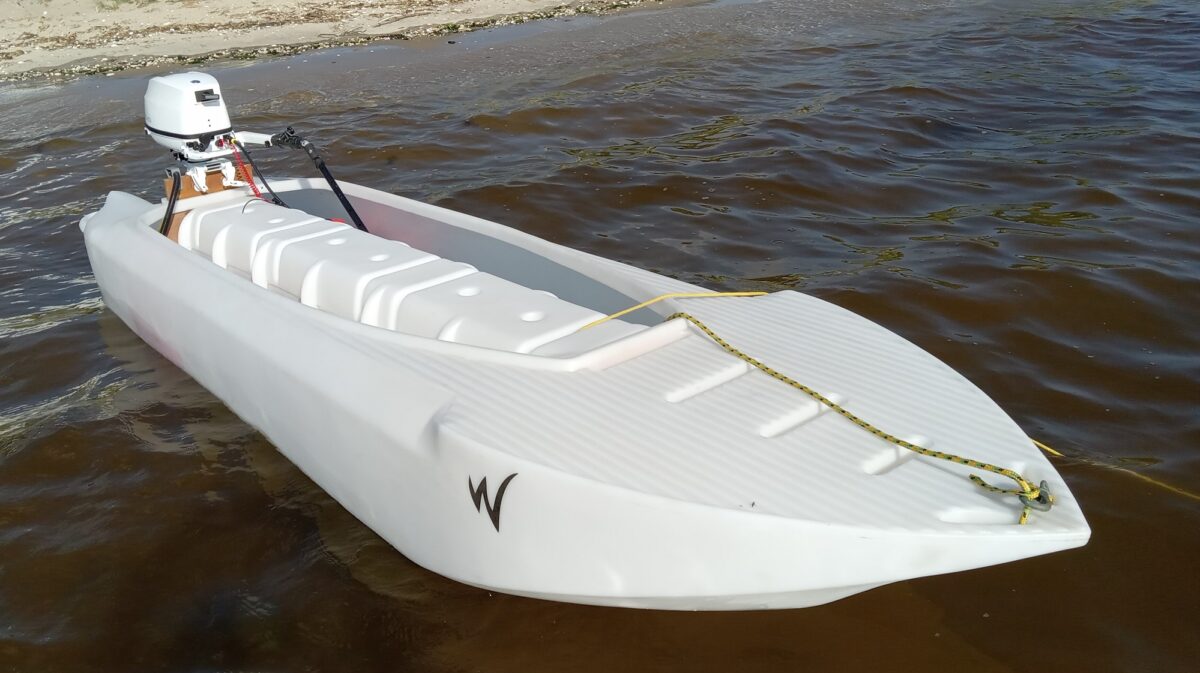What is a microskiff?
Typically, a microskiff is a small, lightweight, flat bottomed motorboat used for flats fishing as well as in protected bays, estuaries, lakes and slow moving rivers, by a crew of one or two anglers. Some would trace the microskiff lineage to dinghies.
Small and lightweight in this case means a boat transported by trailer, and therefore requiring to be launched and beached at a boat ramp.
Microskiff’s propulsion problem
Microskiff are made to be propelled primarily by outboard motors, and the typical microskiff is too wide and heavy to allow for paddling. This is problematic for a number of reasons –
To begin with, an outboard motor can run out of gas, or stall due to a technical problem, and the electric trolling motor that many microskiff have on board isn’t enough for effective traveling over longer distances.
But more importantly, both outboard gas motors and electric trolling motors use propellers that must be immersed in water at a certain height, so the effective draft of a microskiff under motor is quite high, and often too high for really shallow water, a.k.a “skinny water”.
This problem also limits the typical microskiff as far as launching and beaching locations are concerned, and this means that you must launch and beach it from a boat ramp, which is a major source of frustration over a lot of wasted fishing time.
To add insult to injury, propellers don’t do well in the presence of aquatic vegetation, be it seaweed, grass, etc. This is particularly frustrating to anglers who realize that such waters are among the best fisheries.
Human powered propulsion – Poling, anyone?
Microskiff manufacturers often show pictures of people who use a long push-pole to propel their microskiff through shallow water. This human powered mode of propulsion is indeed possible, but it’s not that practical –
To begin with, poling involves long intervals between each pole push, so the big effort invested in each push that accelerates the boat goes to waste when the boat decelerates while you are busy lifting the pole and sticking it back into the water. Acceleration is particularly demanding in energy terms, and in other words, the fact that microskiff are wide and heavy makes them lose speed quickly, and thereby drain your energy.
Few people can push a typical microskiff over a distance of more than several hundred yards, and that’s not enough in terms of real-world fishing.
On top of this, the hull of a typical microskiff is not designed for effective tracking – It’s neither very long nor narrow, and it lacks elements such as fins, skegs or tunnels that could improve its directional stability. The result is that poling in a straight line becomes harder, which means you waste an additional and considerable amount of energy because your microskiff zigzags instead of going straight forward.
Poling is far from being on par with more effective means of human powered propulsion such paddling and rowing.
Conclusion – A better microskiff should allow its crew to go in shallow water and vegetation-rich water in a human powered propulsion mode other than poling, and preferably paddling, since effective rowing requires good technique that can be acquired only through much practice.
An ideal microskiff for real-world fishing
Ideally, a microskiff should allow for either a crew of two fishermen or a solo fisherman to launch, beach, motorize, fish and paddle in any type of water, whether standing up or seated. This means that such a boat should be highly stable yet narrow enough for effective paddling, and only the patented, catamaran-style Wavewalk™ from the new 700 series offers to work as a both a full tandem and solo skiff in the sense that it works perfectly well for one person too, when the second crew member is missing. The fact that the W700 features two long and narrow catamaran-style hulls helps it track better than other craft of similar size, and that helps poling as well as paddling it, with either dual-blade (kayak) paddles or single-blade paddles – canoeing style.
The ideal microskiff should also be lightweight enough to allow for trailer-free transportation, and car-topping by one person, in case no fishing buddy is present. Again, the only two-person microskiff that offers such advantage is the new Wavewalk™ 700, which weighs just 80 lbs without a motor and accessories. In fact, this weight is lower than that of most high-end fishing kayaks out there, including sit-on-top (SOT) and sit-in models, especially tandem fishing kayaks, which are heavier than regular ones.
Trailer-free with triple propulsion capability
The redefined microskiff is trailer-free I.E. easy to car top even for one person, suitable for choppy water, skinny water and vegetation-rich water, and accommodates two full size fishermen fishing standing in comfort. It can be easily and comfortably driven with a powerful outboard motor of up to 5 HP, as well as with electric motors.
One or two people can easily paddle it kayak-style or in the traditional canoeing style, and it lends itself to poling more easily and effectively than any other microskiff does, including solo skiffs, I.E. microskiff for just one person.
Such is the new Wavewalk™ 700 series.
